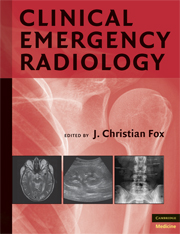Book contents
- Frontmatter
- Contents
- Contributors
- PART I PLAIN RADIOGRAPHY
- PART II ULTRASOUND
- PART III COMPUTED TOMOGRAPHY
- 28 CT in the ED: Special Considerations
- 29 CT of the Spine
- 30 CT Imaging of the Head
- 31 CT Imaging of the Face
- 32 CT of the Chest
- 33 CT of the Abdomen and Pelvis
- 34 CT Angiography of the Chest
- 35 CT Angiography of the Abdominal Vasculature
- 36 CT Angiography of the Head and Neck
- 37 CT Angiography of the Extremities
- PART IV MAGNETIC RESONANCE IMAGING
- Index
- Plate Section
29 - CT of the Spine
from PART III - COMPUTED TOMOGRAPHY
Published online by Cambridge University Press: 07 December 2009
- Frontmatter
- Contents
- Contributors
- PART I PLAIN RADIOGRAPHY
- PART II ULTRASOUND
- PART III COMPUTED TOMOGRAPHY
- 28 CT in the ED: Special Considerations
- 29 CT of the Spine
- 30 CT Imaging of the Head
- 31 CT Imaging of the Face
- 32 CT of the Chest
- 33 CT of the Abdomen and Pelvis
- 34 CT Angiography of the Chest
- 35 CT Angiography of the Abdominal Vasculature
- 36 CT Angiography of the Head and Neck
- 37 CT Angiography of the Extremities
- PART IV MAGNETIC RESONANCE IMAGING
- Index
- Plate Section
Summary
CT of the spine is becoming one of the most common studies in the modern ED. Typically, CT is more sensitive than plain film for many pathologies, less expensive and faster than MRI, and usually available at all hours of the day. With new multislice helical scanners in many EDs, it is possible to get a complete scan with multiple protocols in less than 15 min door to door. This has obvious advantages over taking multiple plain films of the head, neck, chest, spine, and abdomen. Although the fixed cost of a CT scan is more expensive, a single trip to CT may save time, decreasing nursing and technologists' costs over multiple plain films with multiple trips to radiology (1). More importantly, CT yields a faster and more accurate diagnosis, leading to increased patient safety and satisfaction.
CLINICAL INDICATIONS
Trauma is one of the most common presentations to the ED that indicates the use of spinal CT to rule out, confirm or further evaluate injury. There are very well-established protocols that should be followed before resorting to the use of imaging to evaluate injury in the trauma patient. The National Emergency X-Radiography Utilization Study was conducted to evaluate the need for radiographic images in trauma patients with suspected mechanisms of spinal injury (2).
Keywords
- Type
- Chapter
- Information
- Clinical Emergency Radiology , pp. 404 - 419Publisher: Cambridge University PressPrint publication year: 2008

